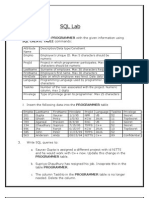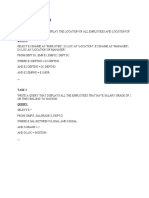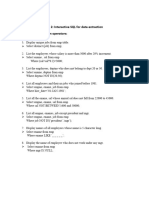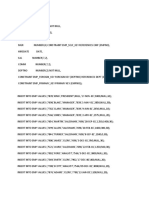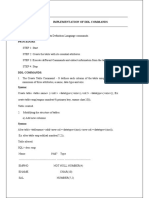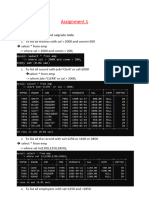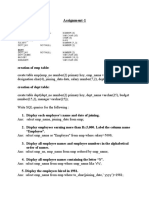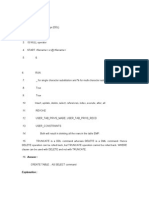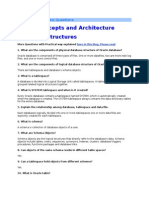0% found this document useful (0 votes)
178 views38 pagesSQL Commands for Beginners
1. The document describes various DDL, DML, and other SQL commands and queries. It includes creating, altering, and dropping tables, inserting, updating, deleting, and selecting data, aggregation functions, joins, and nested queries.
2. Tasks include creating EMP and DEPT tables, inserting data, adding/modifying columns, setting primary and foreign keys, aggregation queries by job, department, nested queries to find highest salaries, and joins between EMP and DEPT tables.
3. The tasks cover a wide range of SQL commands and techniques including DDL, DML, aggregation, grouping, nested and correlated subqueries, and joins to demonstrate SQL fundamentals.
Uploaded by
Prithvi Sriman Maddukuri MaddukuriCopyright
© © All Rights Reserved
We take content rights seriously. If you suspect this is your content, claim it here.
Available Formats
Download as PDF, TXT or read online on Scribd
0% found this document useful (0 votes)
178 views38 pagesSQL Commands for Beginners
1. The document describes various DDL, DML, and other SQL commands and queries. It includes creating, altering, and dropping tables, inserting, updating, deleting, and selecting data, aggregation functions, joins, and nested queries.
2. Tasks include creating EMP and DEPT tables, inserting data, adding/modifying columns, setting primary and foreign keys, aggregation queries by job, department, nested queries to find highest salaries, and joins between EMP and DEPT tables.
3. The tasks cover a wide range of SQL commands and techniques including DDL, DML, aggregation, grouping, nested and correlated subqueries, and joins to demonstrate SQL fundamentals.
Uploaded by
Prithvi Sriman Maddukuri MaddukuriCopyright
© © All Rights Reserved
We take content rights seriously. If you suspect this is your content, claim it here.
Available Formats
Download as PDF, TXT or read online on Scribd
/ 38

